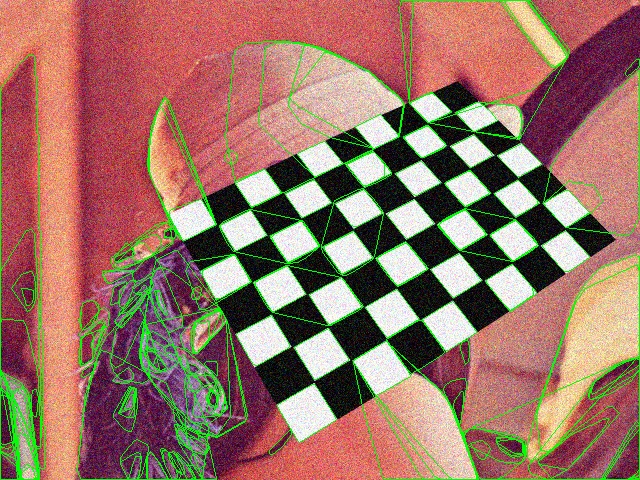最大穩定極值區域MSERs
引言簡述
Harris興趣點檢測器是一種產生平移旋轉不變結果的演算法。當噪聲和離散化的影響可以忽略時,Harris檢測器作用於旋轉或平移過程的影象,其輸出是一組旋轉或平移的點集。然而,如果影象被縮放或經過射影變換,則Harris檢測器的輸出也會劇烈變化。最大穩定極值區域(Maximally Stable Extremal Regions MSERs)是一種影象結構,不僅是是在平移和旋轉後,即便是經歷相似仿射變換,它仍可被重複檢測出來。
基本理論
MSER檢測過程:假如一幅灰度圖 I所有可能的閾值,比如通用的範圍S = [0,1, 2..., 255] 。對於低於閾值的畫素,其稱為黑色畫素,高於閾值的則稱為白色畫素。如果要想顯示閾值化的影象It
演算法:遍歷極值區域
輸入:影象 I
輸出:巢狀的極值區域列表
1. 對按強度排序的所有畫素:
1)在影象中放置畫素
2)更新連通分量結構
3)更新影響到的連通分量的面積
2. 對所有連通區域:
連通分量面積的變化率區域性極小值即為穩定的閾值
該過程產生了一個數據結構,其中儲存了每個連通分量的面積,為閾值的函式。兩個分量的合併可視為較小分量的消忘,然後小分量的所有畫素全部加入大的分量。最後,面積函式變化率的區域性極小值的強度級別,即被選作閾值。在輸出中,每個MSER
參考程式碼
參考程式碼貼出相關部分的MSER.H標頭檔案和MSER.CPP檔案。如下程式碼所示(僅作參考):
MSER.H標頭檔案
#ifndef _MSER_H_ #define _MSER_H_ #include <vector> ......... class MSER { public: // A Maximally Stable Extremal Region. struct Region { int level_; int pixel_; int area_; double moments_[5]; double variation_; Region(int level = 256, int pixel = 0); private: bool stable_; Region * parent_; Region * child_; Region * next_; void accumulate(int x, int y); void merge(Region * child); void detect(int delta, int minArea, int maxArea, double maxVariation, double minDiversity,std::vector<Region> & regions); void process(int delta, int minArea, int maxArea, double maxVariation); bool check(double variation, int area) const; void save(double minDiversity, std::vector<Region> & regions); friend class MSER; }; MSER(int delta = 2, double minArea = 0.0001, double maxArea = 0.5, double maxVariation = 0.5, double minDiversity = 0.33, bool eight = false); void operator()(const uint8_t * bits,int width, int height, std::vector <Region> & regions); .......... private: void processStack(int newPixelGreyLevel,int pixel,std::vector<Region*>®ionStack); std::ptrdiff_t doublePool(std::vector<Region *>®ionStack); // Parameters int delta_; double minArea_; double maxArea_; double maxVariation_; double minDiversity_; bool eight_; // Memory pool of regions for faster allocation std::vector<Region> pool_; std::size_t poolIndex_; .......... }; #endif //_MSER_H_
MSER.CPP
#include "mser.h"
#include <algorithm>
#include <cassert>
#include <limits>
MSER::MSER(int delta, double minArea, double maxArea,double maxVariation,
double minDiversity,bool eight):eight_(eight),delta_(delta),
minArea_(minArea), maxArea_(maxArea),maxVariation_(maxVariation),
minDiversity_(minDiversity), pool_(256), poolIndex_(0)
{
// Parameter check
assert(delta > 0);
assert(minArea >= 0.0);
assert(maxArea <= 1.0);
assert(minArea < maxArea);
assert(maxVariation > 0.0);
assert(minDiversity >= 0.0);
assert(minDiversity < 1.0);
}
void MSER::operator()(const uint8_t * bits, int width, int height, vector<Region> & regions)
{
vector<bool> accessible(width * height);
vector<int> boundaryPixels[256];
int priority = 256;
vector<Region *> regionStack;
regionStack.push_back(new (&pool_[poolIndex_++]) Region);
int curPixel = 0;
int curEdge = 0;
int curLevel = bits[0];
accessible[0] = true;
regionStack.push_back(new (&pool_[poolIndex_++]) Region(curLevel, curPixel));
if (poolIndex_ == pool_.size())
doublePool(regionStack);
for (;;) {
const int x = curPixel % width;
const int y = curPixel / width;
for (; curEdge < (eight_ ? 8 : 4); ++curEdge) {
int neighborPixel = curPixel;
if (eight_) {
switch (curEdge) {
case 0: if (x < width - 1)
neighborPixel = curPixel + 1; break;
case 1: if ((x < width - 1) && (y > 0))
neighborPixel = curPixel - width + 1; break;
case 2: if (y > 0)
neighborPixel = curPixel - width; break;
case 3: if ((x > 0) && (y > 0))
neighborPixel = curPixel - width - 1; break;
case 4: if (x > 0)
neighborPixel = curPixel - 1; break;
case 5: if ((x > 0) && (y < height - 1))
neighborPixel = curPixel + width - 1; break;
case 6: if (y < height - 1)
neighborPixel = curPixel + width; break;
default: if ((x < width - 1) && (y < height - 1))
neighborPixel = curPixel + width + 1; break;
}
}
else {
switch (curEdge) {
case 0: if (x < width - 1)
neighborPixel = curPixel + 1; break;
case 1: if (y < height - 1)
neighborPixel = curPixel + width; break;
case 2: if (x > 0)
neighborPixel = curPixel - 1; break;
default: if (y > 0)
neighborPixel = curPixel - width; break;
}
}
if (neighborPixel != curPixel && !accessible[neighborPixel]) {
const int neighborLevel = bits[neighborPixel];
accessible[neighborPixel] = true;
if (neighborLevel >= curLevel) {
boundaryPixels[neighborLevel].push_back(neighborPixel << 4);
if (neighborLevel < priority)
priority = neighborLevel;
}
else {
boundaryPixels[curLevel].push_back((curPixel << 4)|(curEdge + 1));
if (curLevel < priority)
priority = curLevel;
curPixel = neighborPixel;
curEdge = 0;
curLevel = neighborLevel;
goto step_3;
}
}
}
regionStack.back()->accumulate(x, y);
if (priority == 256) {
regionStack.back()->detect(delta_, minArea_ * width * height,
maxArea_ * width * height, maxVariation_, minDiversity_,regions);
poolIndex_ = 0;
return;
}
curPixel = boundaryPixels[priority].back() >> 4;
curEdge = boundaryPixels[priority].back() & 15;
boundaryPixels[priority].pop_back();
while (boundaryPixels[priority].empty() && (priority < 256))
++priority;
const int newPixelGreyLevel = bits[curPixel];
if (newPixelGreyLevel != curLevel) {
curLevel = newPixelGreyLevel;
processStack(newPixelGreyLevel, curPixel, regionStack);
}
}
}
void MSER::processStack(int newPixelGreyLevel,int pixel,vector<Region *> ®ionStack)
{
do {
Region * top = regionStack.back();
regionStack.pop_back();
if (newPixelGreyLevel < regionStack.back()->level_) {
regionStack.push_back(new(&pool_[poolIndex_++]);
Region(newPixelGreyLevel,pixel));
if (poolIndex_ == pool_.size())
top = reinterpret_cast<Region *>(reinterpret_cast<char *>(top) +
doublePool(regionStack));
regionStack.back()->merge(top);
return;
}
regionStack.back()->merge(top);
}
while (newPixelGreyLevel > regionStack.back()->level_);
}
ptrdiff_t MSER::doublePool(vector<Region *> & regionStack)
{
assert(!pool_.empty());
vector<Region> newPool(pool_.size() * 2);
copy(pool_.begin(), pool_.end(), newPool.begin());
const ptrdiff_t offset = reinterpret_cast<char *>(&newPool[0]) -
reinterpret_cast<char *>(&pool_[0]);
for (size_t i = 0; i < pool_.size(); ++i) {
if (newPool[i].parent_)
newPool[i].parent_ = reinterpret_cast<Region *>(
reinterpret_cast<char *>(newPool[i].parent_) + offset);
if (newPool[i].child_)
newPool[i].child_ = reinterpret_cast<Region *>(
reinterpret_cast<char *>(newPool[i].child_) + offset);
if (newPool[i].next_)
newPool[i].next_ = reinterpret_cast<Region *>(
reinterpret_cast<char *>(newPool[i].next_) + offset);
}
for (size_t i = 0; i < regionStack.size(); ++i)
regionStack[i] = reinterpret_cast<Region *>(
reinterpret_cast<char *>(regionStack[i]) + offset);
pool_.swap(newPool);
return offset;
}
.........
Python版MSERS
import numpy as np
import cv2
import video
if __name__ == '__main__':
import sys
try: video_src = sys.argv[1]
except: video_src = 0
cam = video.create_capture(video_src)
mser = cv2.MSER()
while True:
ret, img = cam.read()
gray = cv2.cvtColor(img, cv2.COLOR_BGR2GRAY)
vis = img.copy()
regions = mser.detect(gray, None)
hulls = [cv2.convexHull(p.reshape(-1, 1, 2)) for p in regions]
cv2.polylines(vis, hulls, 1, (0, 255, 0))
cv2.imshow('img', vis)
if 0xFF & cv2.waitKey(5) == 27:
break
cv2.destroyAllWindows()
測試輸出
經測試輸出視訊影象分析所得:MSER檢測有時也有閾值化有關,每個極值區域是閾值化影象的一個連通分量。然而,並不需要全域性或"最優"的閾值,測試所有的閾值,連通分量的穩定性都經過評估。最終,分水嶺是輸入影象的劃分,而如果某些影象部分仍有穩定的閾值存在的話MSER就可能是巢狀的。
參考文獻
[1] J. Matas, O. Chum, M. Urban, and T. Pajdla. Proc. of British Machine Vision Conference, pages 384-396, 2002.
關於Image Engineering & Computer Vision的更多討論與交流,敬請關注本博和新浪微博songzi_tea.

